[[CCCats]] ⦿ [[Crooks]] ⦿ [[Gravents]] ⦿ [[Nautipods]]
Crook Traits
Fur/Coat
Ears
Eyes
Teeth
Tongue
Tendrils
Tail
Body
Misc.
Required
- 1 Pattern Minimum
- Muzzle Patch - [A bald patch of smooth, very short fur or skin on the muzzle. Must be clearly separate in texture]
Common
- Sphinx Fur - [Hairless, or nearly hairless]
- Furred - [Can be curly, straight, wavy, etc. All hair textures available]
- Royal Fur - [Any long strands of fur that are noticeably longer than the rest of the design's fur. This includes ribbons, ponchos, long ankle fur, etc. All pieces must still resemble and act like fur/hair]
- Frankenstein Fur - [Patches of normal fur and furless patches separated by an abrupt change in length]
- Frankenstein Markings - [Two different sets of markings that stop abruptly against each other, like chimerism]
- Piebald Markings - [Solid color splotching above all patterns. Considered a "blurry memory"]
- Cheesepuff - [Excessive full body fur]
Common Fur Visual Examples

Uncommon
- Sparkling Markings - [A marking type that sparkles -- Effects 3 colors on the body. This trait includes the teeth and tongue]
- Particle Markings - [Particles that trail from a specific marking. These can be shaped, but must be small particles]
Uncommon Fur Visual Examples
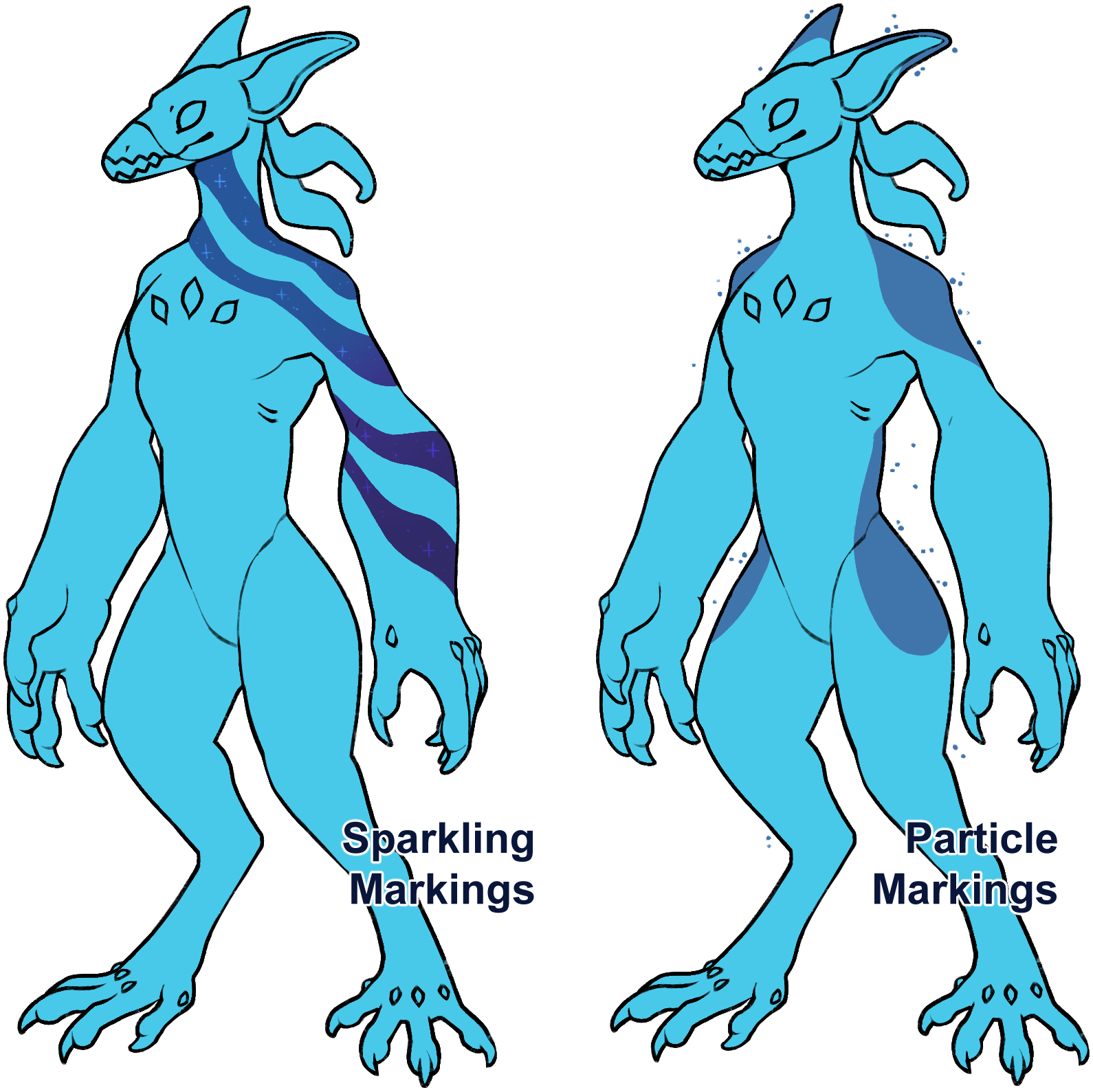
Rare
- Glowing Markings - [A marking type that glows -- Effects 3 colors on the body. Glow must be the same color as the color that is glowing. This trait includes the teeth and tongue]
- Metallic Markings - [Markings that reflect light like metal -- They do not change color. Effects 3 colors on the body. This trait includes the teeth and tongue]
- Opalescent Markings - [Markings shimmer different colors in light -- Effects 3 colors on the body. This trait includes the teeth and tongue]
- Elongated Face Patch - [Muzzle patch extends further down the face, usually onto neck]
Rare Fur Visual Examples
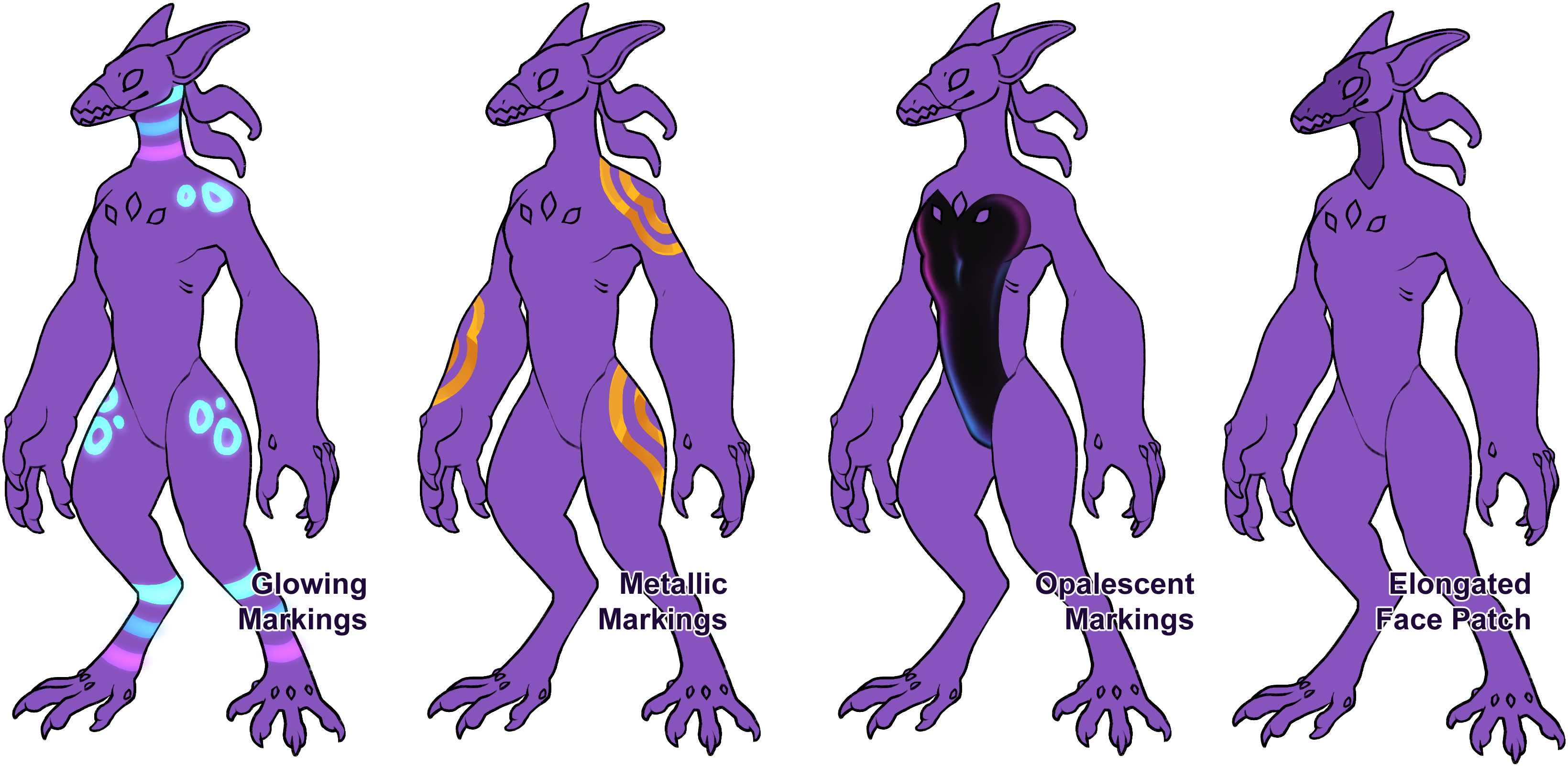
Myth
- Color-Changing Markings - [Markings that change color because of mood, willpower, or otherwise. -- Effects 3 colors on the body. Can change from one color to another color for a total of two]
- Color-Changing Coat - [Base coat that changes color because of mood, willpower, or otherwise. Only applies to the base color]
- Glowing Coat - [A glowing effect that affects all colors on the body. This trait includes the teeth and tongue]
- Metallic Coat - [A metallic sheen that affects all colors on the body. This trait includes the teeth and tongue]
- Opalescent Coat - [An opalescent sheen that affects all colors on the body. This trait includes the teeth and tongue]
- Sparkling Coat - [Sparkles that affect all colors on the body. This trait includes the teeth and tongue]
Myth Fur Visual Examples

Oddity
- Second Set of Colors - [Coat that can completely change all of its colors -- NOT markings. This covers one extra set of colors, for a total of two. Tongue and Eye colors cannot change]
- Shifting Markings - [Coat that can change its markings/patterns -- NOT colors. Examples are eyes that blink, swirls that spin, and generally change appearance. It must remain visually similar]
- Rainbow Shift - [A set of markings can shift between all colors of the rainbow]
Oddity Fur Visual Examples

Unseen Affliction
- -
Lore-breaking
Required
- 2 Ears Minimum - [Loss due to injury is not traited but must still show evidence an ear was once present]
Common
- Fluffy Ears
- Furless Ears
- Bent Ears
- Oddly Shaped Ears - [Ears may have odd shapes, holes, and different lengths]
- Mismatched Ears - [Ears may be asymmetrical]
- Droopy Ears - [Ears that are droopy or floppy at the base]
Common Ear Visual Examples

Uncommon
- Multiple Ears (3-4) - [Ears can be placed asymmetrically as long as they are placed in general ear position]
Uncommon Ear Visual Examples
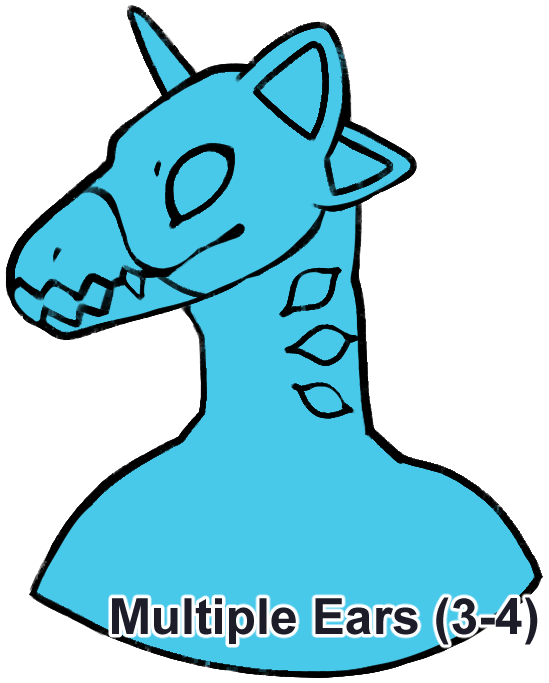
Rare
- Multiple Ears (5-6) - [Ears can be placed asymmetrically as long as they are placed in general ear position]
- Linked Ears - [Ears that are merged together above the base]
Rare Ear Visual Examples

Myth
- Multiple Ears (7-10) - [Ears can be placed asymmetrically as long as they are placed in general ear position]
- Overgrown (Ears) - [Ears that are very clearly larger than are proportional to the character]
- Wing Ears - [Grants levitation magic. Can be bat or feathered, or a mix of the two, and can articulate like wings]
Myth Ears Visual Examples

Oddity
- -
Unseen Affliction
- -
Lore-breaking
- No Ears
Required
- 2 True Eyes - [Always located on head, must have at least three colors to be considered common]
- Eye Cluster - [At least one cluster of eyes located somewhere on the body. Must have at least 3 additional eyes. No color restrictions, but at least three colors OR a target pattern of more than three rings must be present in the eye]
Common
- Symmetrical Clusters - [Clusters can occupy both sides of the same half, for example both arms or legs, as well as travel from one limb to the body, so long as the cluster is continuous]
- Spiral / Target Pattern
- Rounded Pupil
- Slit Pupil
- Third Eye - [A third true eye may be placed on the forehead between the other two true eyes]
Common Eye Visual Example
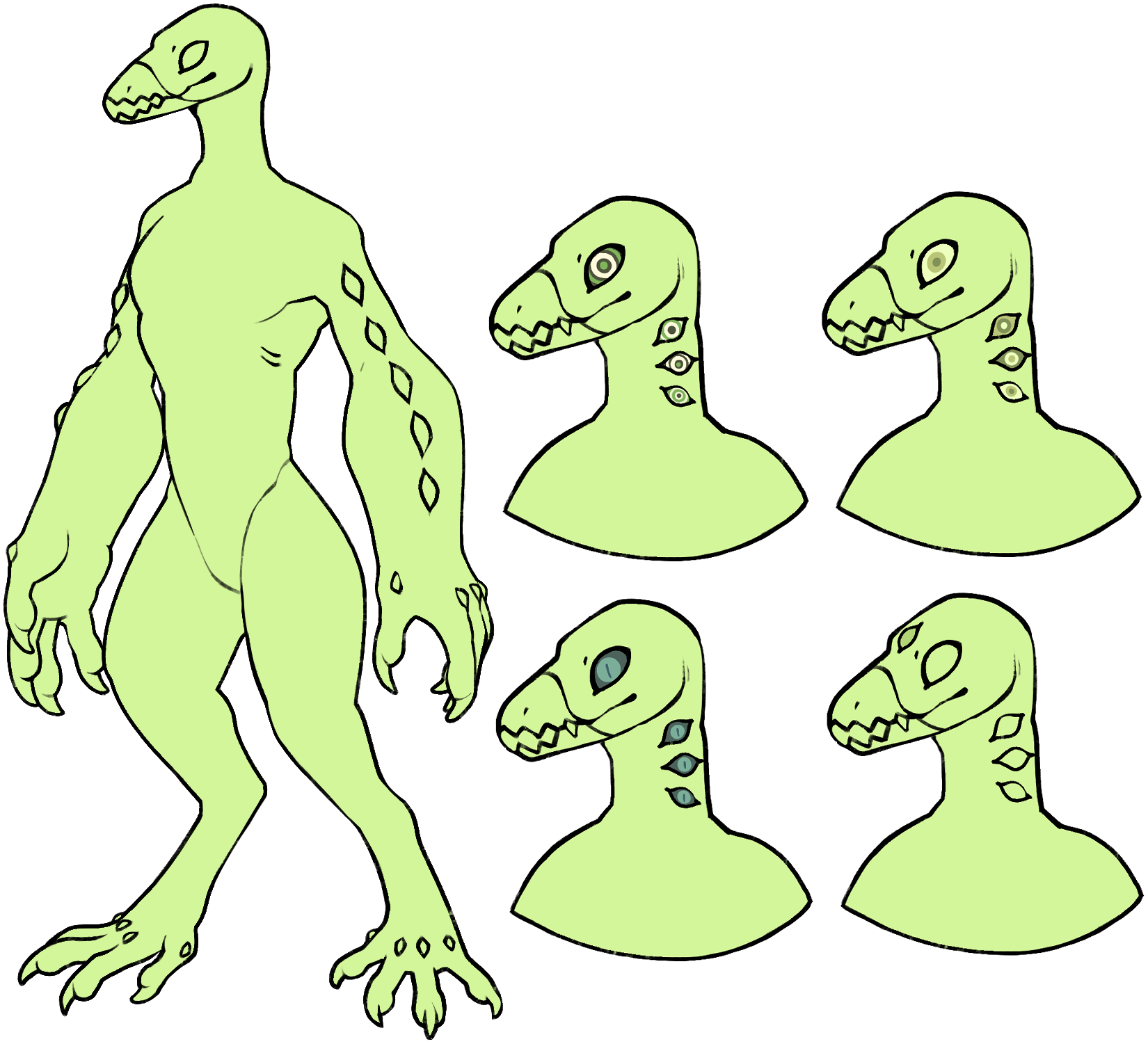
Uncommon
- Patterned Eyes - [An eye that can have any pattern, as long as a 'pupil' pattern is visible]
- Sparkling Eyes - [Eye that sparkles. Sparkles should not fall from the eye]
- Heterochromia - [True eyes only. Cluster eyes can be multicolored but must resemble each other somehow]
Uncommon Eye Visual Examples
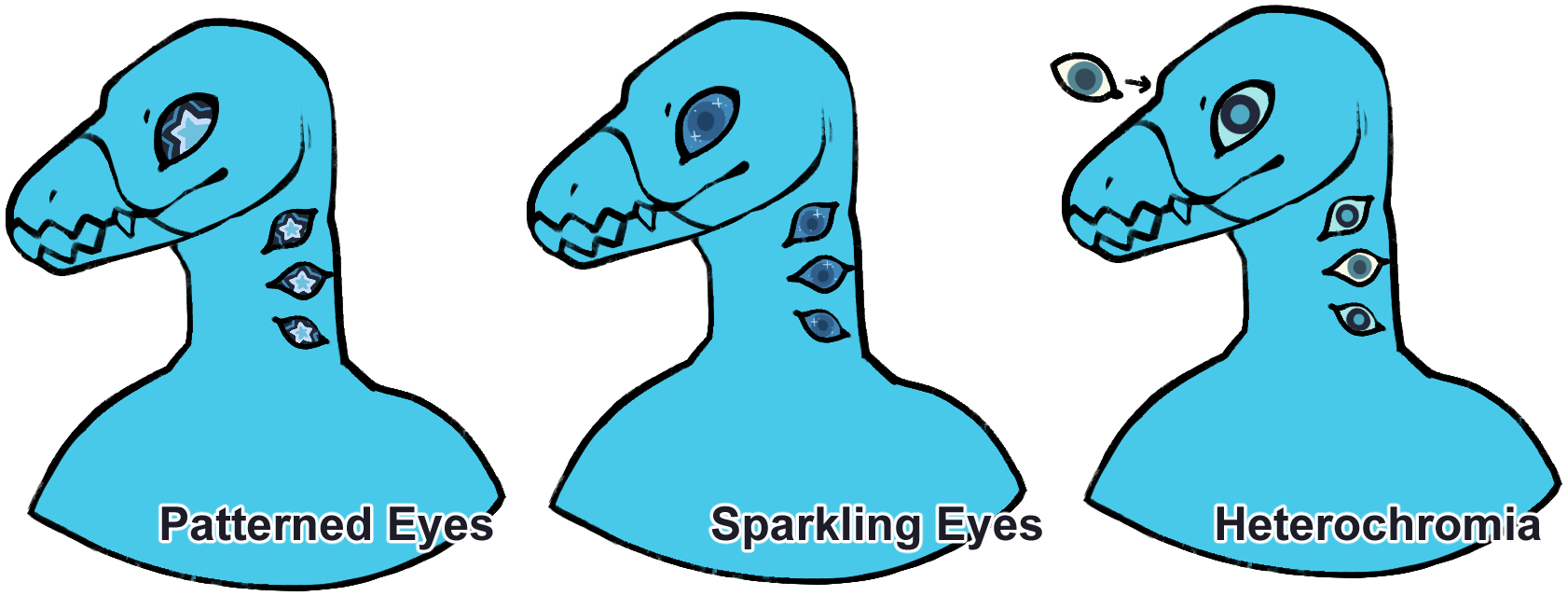
Rare
- Glowing Eyes - [Entire eye or parts of it glow. It must glow the same color as the eye]
- Metallic Eyes - [Eye that has an overall metallic sheen]
- Opalescent Eyes - [Eyes have an overall opal sheen]
- Solid Eyes - [No pattern present in the eyes, including if there are 2 or less colors. Can either have one or no visible pupil]
Rare Eye Visual Examples

Myth
- Pattern Shifting Eye (1-5) - [The pattern of the eye shifts. Patterns should have a similar base to avoid appearing as a completely different eye. This creates up to five patterns total]
- 25+ Eyes
- Multiple Clusters - [Clusters disconnected from one another located on different parts of the body. Clusters may continue from one body part to another and count as one, but once split count for multiple]
Myth Eye Visual Examples

Oddity
- Pattern-Shifting Eye (6-10) - [The pattern of the eye shifts. Patterns should have a similar base to avoid appearing as a completely different eye. This creates up to ten patterns total]
- Elemental Eye - [An eye with features or made up of elemental substances]
- Cracked Eye - [An eye that is cracked, allowing essence to escape. For CCCats this is depicted as a dripping substance from the crack]
- Cursed Eye - [An eye that inflicts a curse or pain on others or the owner. May have odd shapes or anomalies]
- Essence-Leaking Eyes - [Eyes that leak essence, the lifeblood of the Wormling eyes -- Essence is unique in that it will appear misty or smoke-like with Crooks]
Oddity Eye Visual Examples

Unseen Affliction
- Full Body Cluster Eyes - [Eyes that cover the entire body]
Unseen Eye Visual Examples
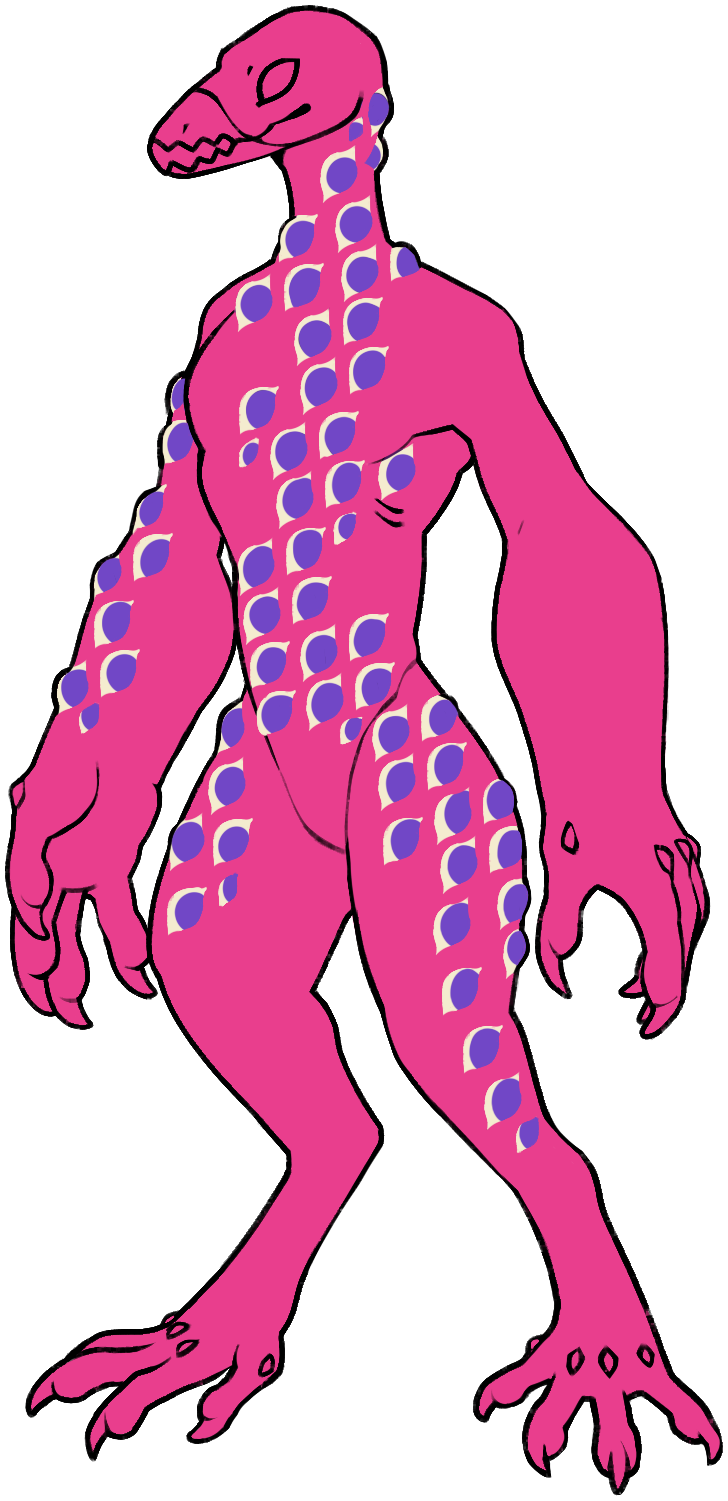
Lore-breaking
- Internal Cluster - [Cluster located inside the body. Clusters can be located on the tongue without counting as an internal cluster, so long as there are cluster eyes visible on the face as well]
- No Eyes
Required
- Visible External Front Teeth - [Teeth located externally on the muzzle patch. They do not have to be clearly defined but must be pointed]
- Human Toothed Interior - [A smaller set of humanoid teeth hidden within the mouth]
Common
- Beak Tooth - [A front tooth that is large and beak-like. Must be shown as separate from the shape of the snout.]
- Diamond - [Teeth are diamond shaped]
- Dull - [Teeth are a duller, but still pointed shape]
- Gapped Teeth - [Teeth have gaps between them, areas of uneven space or the absence of teeth]
- Razor Teeth - [Thinner, sharp teeth]
- Messy Teeth - [Teeth that overlap, slant, or turn at an odd angle. Teeth should remain similar in size]
- Multi-Colored Teeth - [Teeth with more than one color]
- Overbite/Underbite - [One row of teeth overlays over the other]
- Saber Teeth - [Two large upper-mouth teeth, externally visible]
- Fangs - [Two visibly larger teeth, only visible when mouth open]
- Tusks - [Two large lower-mouth teeth, externally visible]
- Tipsy Turvy Teeth - [One tusk, one saber tooth on opposing sides]
- Snaggletooth - [One externally visible tooth, either tusk, saber, or fang]
- Needle Teeth - [Long teeth that are so long that they cannot fully close. Interlocks like a venus fly trap]
- Internal Row of Teeth - [One row inside of the mouth, different from external front teeth]
Common Teeth Visual Examples
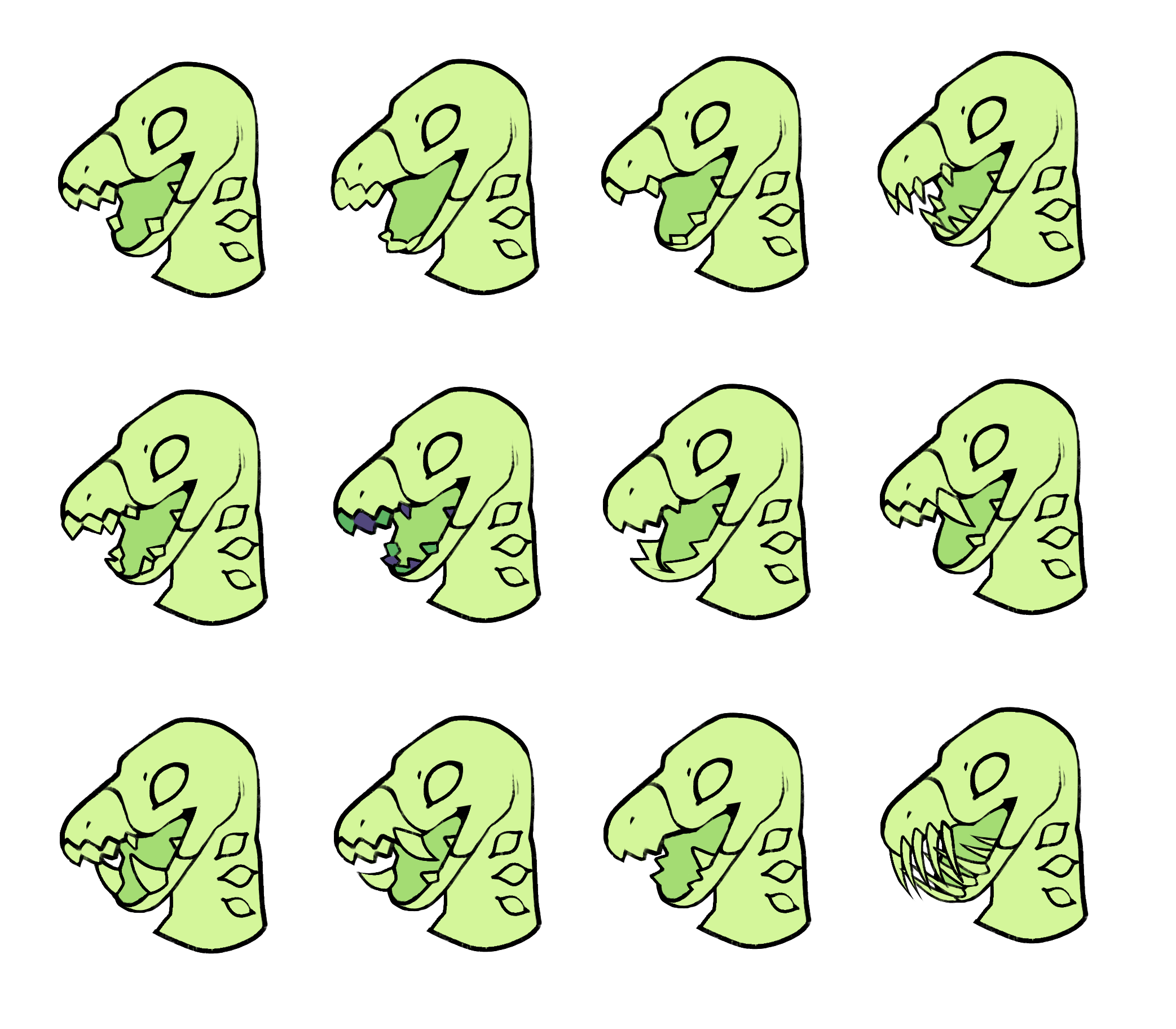
Uncommon
- -
Rare
- -
Myth
- Extra Rows of Teeth - [Extra rows of teeth, usually full rows behind the front row, though it can also be done externally so long as the teeth are visibly teeth. Usually up to 2 rows]
- Overgrown Teeth -[Teeth that are very clearly larger than are proportional to the character]
Myth Teeth Visual Examples
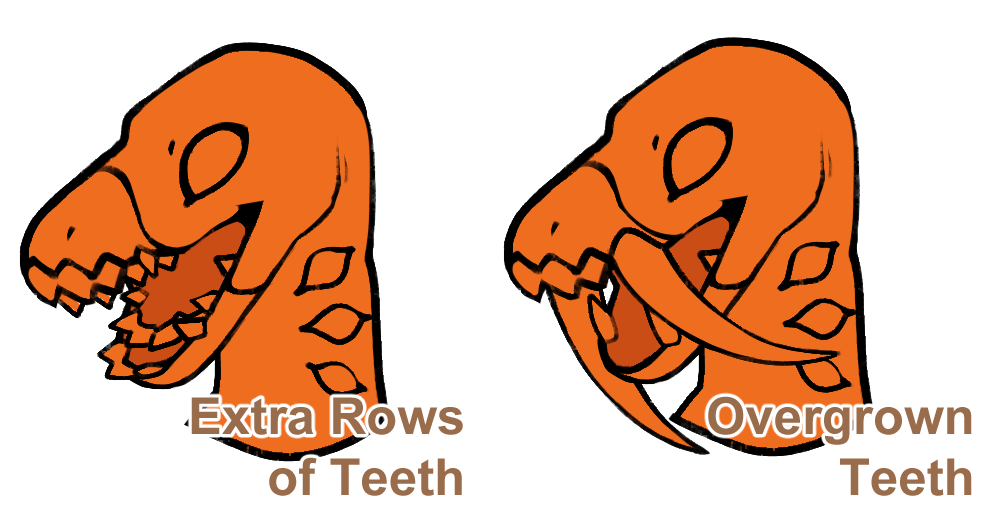
Oddity
- -
Unseen Affliction
- -
Lore-breaking
- Human Teeth - [This signifies that a Crook took a human host. These beings are hunted by humans and are seen as truce-breakers]
- No Teeth
Lore-Breaking Teeth Visual Examples
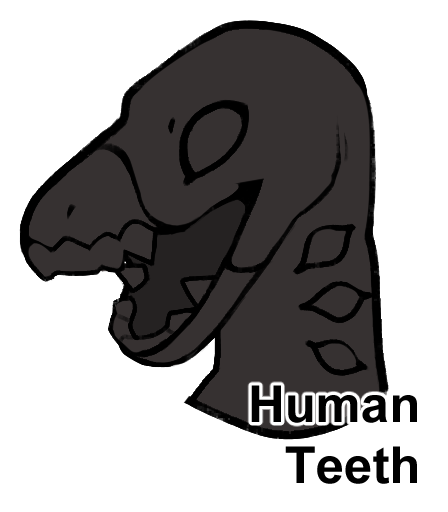
Required
- 1 Tongue Minimum - [The tongue is different than a CCCat's in that it is not the wormling]
Common
- Striped Tongue - [Variable on amount, shape, and type are all common]
- Spotted Tongue - [A tongue with any variation of spots or speckles. Size and shape can vary, as long as they are small and not stripe-like]
- Striped and Spotted Tongue - [A tongue with both stripes and spots]
- Patternless Tongue
Common Tongue Visual Examples
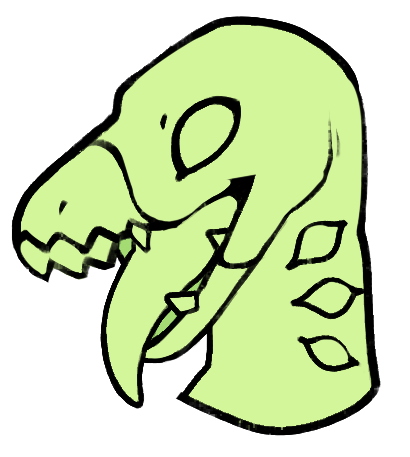
Uncommon
- Multiple Tongues (2-3)
- Thin Tongue - [A Tongue that is thin in width, akin to a hummingbird]
- Thick Tongue - [A tongue that is wide and rounded]
- Spiked Tongue - [A tongue with small spikes]
- Shaped Tongue Tip - [Tip of tongue has minor shape, such as fork or spade]
Uncommon Tongue Visual Examples

Rare
- Multiple Tongues (4-6)
- Ruffled Tongue - [A tongue standard in width, that has a flat frilling running down the sides or center]
- Twin Tongue - [The tongue splits up to halfway]
- Flat Tongue - [A Tongue that is flat in shape. The tongue should not be square, and still follow the standard tapered shape]
- Complex Tongue Tip - [Tip with an abnormal shape, such as a star or three split tongue]
Rare Tongue Visual Examples

Myth
- Multiple Tongues (7-8)
- Odd-Shaped Tongue - [Tongue is oddly shaped, such as unnatural tapers or naturally forming holes.]
- Overgrown Tongue - [Tongue that is very clearly larger than are proportional to the character]
Myth Tongue Visual Examples

Oddity
- Multiple Tongues (9-12)
- Hand Tongue - [The tongue ends in a prehensile hand]
Oddity Tongue Visual Examples
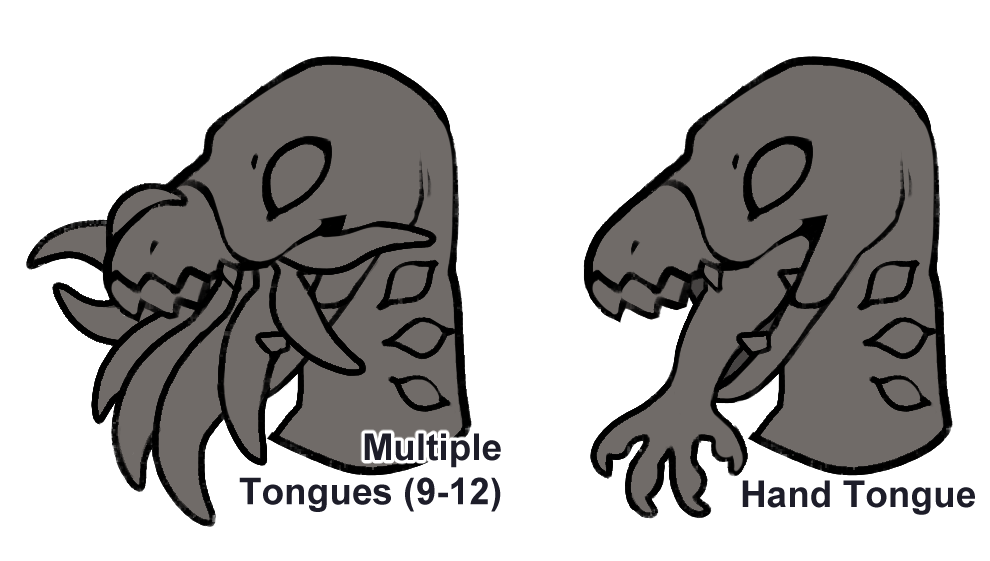
Unseen Affliction
Lore-breaking
- No Tongue
Required
- 2 Tendrils Minimum - [Tendrils can be retracted and summoned at will, but must be shown somewhere on the masterlist]
Common
- Furred Tendrils
- Shoulder to Hip Length Tendrils
- Tendrils on Back of Skull
- Tendrils Down the Neck
- Stubby Tendrils - [Short, but still visible as tendrils]
- Any Pattern - [There is no limit to color or pattern]
- Mixed Length Tendrils
- Spiked Tendrils
- Mix Sized Tendrils - [Tendrils appearing in multiple widths. If you have thin tendrils, the thin tendrils trait is required for this]
- 2 Tendrils
Common Tendril Visual Examples

Uncommon
- Tendrils on Forehead - [Tendrils are placed on forehead, above eyes and in front of the ears]
- Flat Tendrils
- Split Tendrils - [Tendrils that split up to halfway down]
- Shaped Tendril Tip - [Tendril tips mimic shapes like stars or diamonds]
- Thin Tendrils - [Thin tendril width]
- Sparkling Tendrils - [Part of or all of the tendril is sparkling]
- Particle Tendrils - [Non-elemental particles fall from tendrils. These can be shaped, but must be small particles]
Uncommon Tendril Visual Examples

Rare
- 10-24 Tendrils
- Glowing Tendrils - [Part of or all of the tendril is glowing. Glow must be the same color as the color that is glowing]
- Metallic Tendrils - [Part of or all of the tendril is metallic]
- Opalescent Tendrils - [Part of or all of the tendril is opalescent]
- Tendrils on Face/Cheeks
Rare Tendril Visual Examples

Myth
- 25+ Tendrils
- Floating Tendril Piece - [Base is connected but pieces of the tendril float]
- Linked Tendrils - [Tendrils attach elsewhere than the tendril tips]
- Tendrils on Lower Body - [Tendrils placed below the neck area]
- Overgrown (Tendrils) - [Tendrils that are very clearly larger than are proportional to the character]
Myth Tendril Visual Examples

Oddity
- Tendrils on Head and Elsewhere on Body - [Tendrils appear on both the head and lower body]
- Transparent Tendrils - [Tendrils have some blurry transparency]
- Elemental Tendrils - [Tendrils are made up of an element/magic]
Oddity Tendril Visual Examples

Unseen Affliction
- Hand Tendrils - [Tendrils end in a prehensile hand]
- Floating Tendrils - [Tendrils that are disconnected from the body]
- Living Tendrils - [Tendrils end with a mouth or the head of another creature]
Unseen Tendril Visual Examples

Lore-breaking
- No Tendrils
Required
- There are no tail requirements for Crook tails
Common
- Long Tail
- Furred Tail
- Thick Tail
- 1-3 Tails
- Spaded Tail
- Hooked Tail
- Split Tail (1)
Common Tail Visual Examples
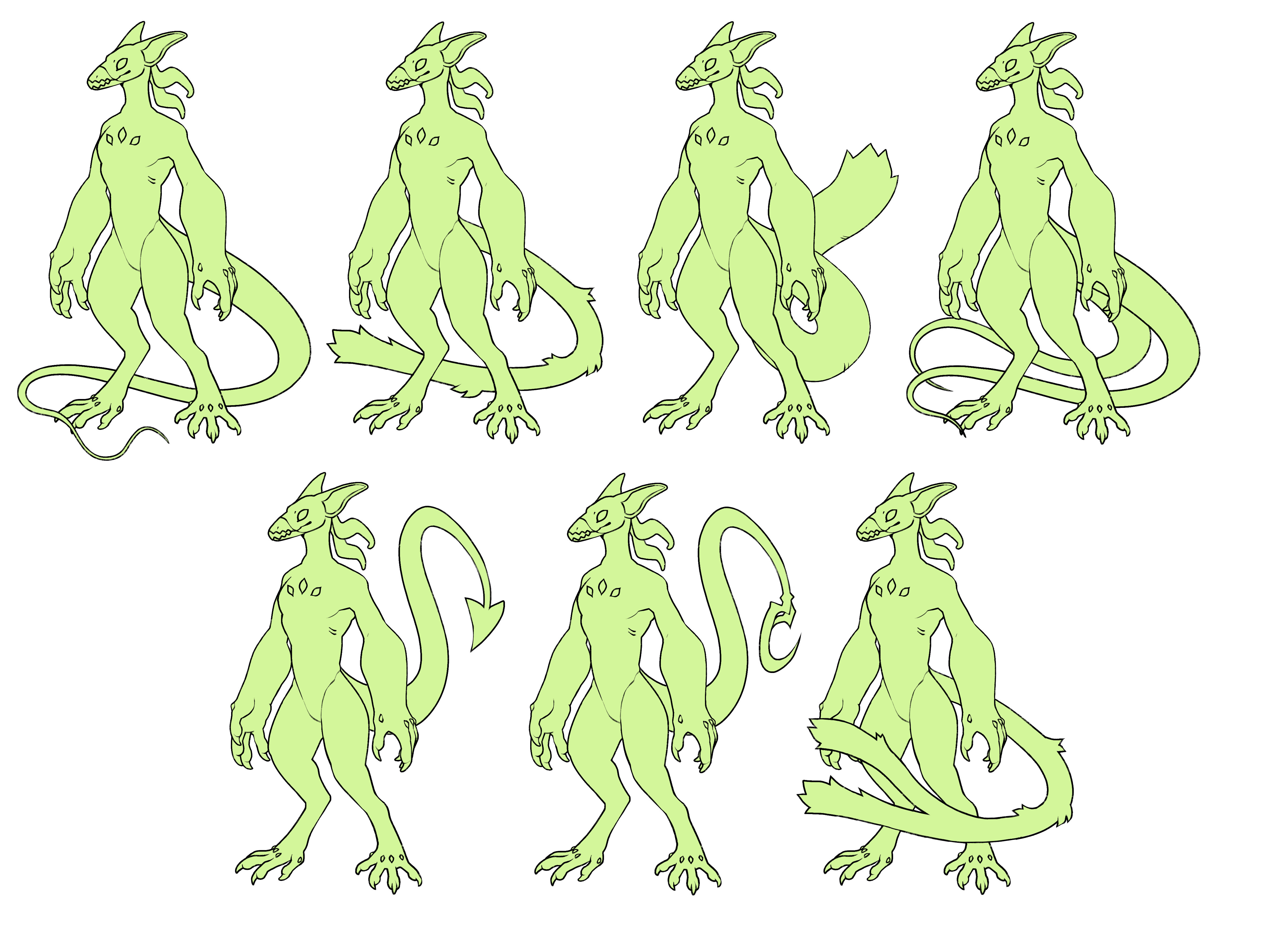
Uncommon
- Multiple Tails (4-5)
- Split Tail (2-5) - [Tail splits to no more than half its length. This can be used to create a branching effect up to 5 times (this number is counted by the number of times the tail splits, not the number of tail tips), but these must not be longer than half the tail length. Branches account for the total number of branches across all tails]
- Shaped Tail Tip - [The tip of the tail can take simple, flat forms such as a heart, star, circle, or club]
- Short Tail
Uncommon Trait Visual Examples

Rare
- Multiple Tails (6-7)
- Split Tail (6-10) - [Tail splits to no more than half its length. This can be used to create a branching effect up to 10 times (this number is counted by the number of times the tail splits, not the number of tail tips), but these must not be longer than half the tail length. Branches account for the total number of branches across all tails]
- Twin Tail - [A tail that splits past half its length, but not at the base. Can be applied to any number of tails]
- No Tail - [No tail is present]
- Object Tail Tip - [A tail that ends with an object of some kind]
- Flat Tail - [Tail is flat. It may have cutouts and shapes along its length, but tail must end in a flat or pointed shape unless other traits are present]
Rare Tail Visual Examples
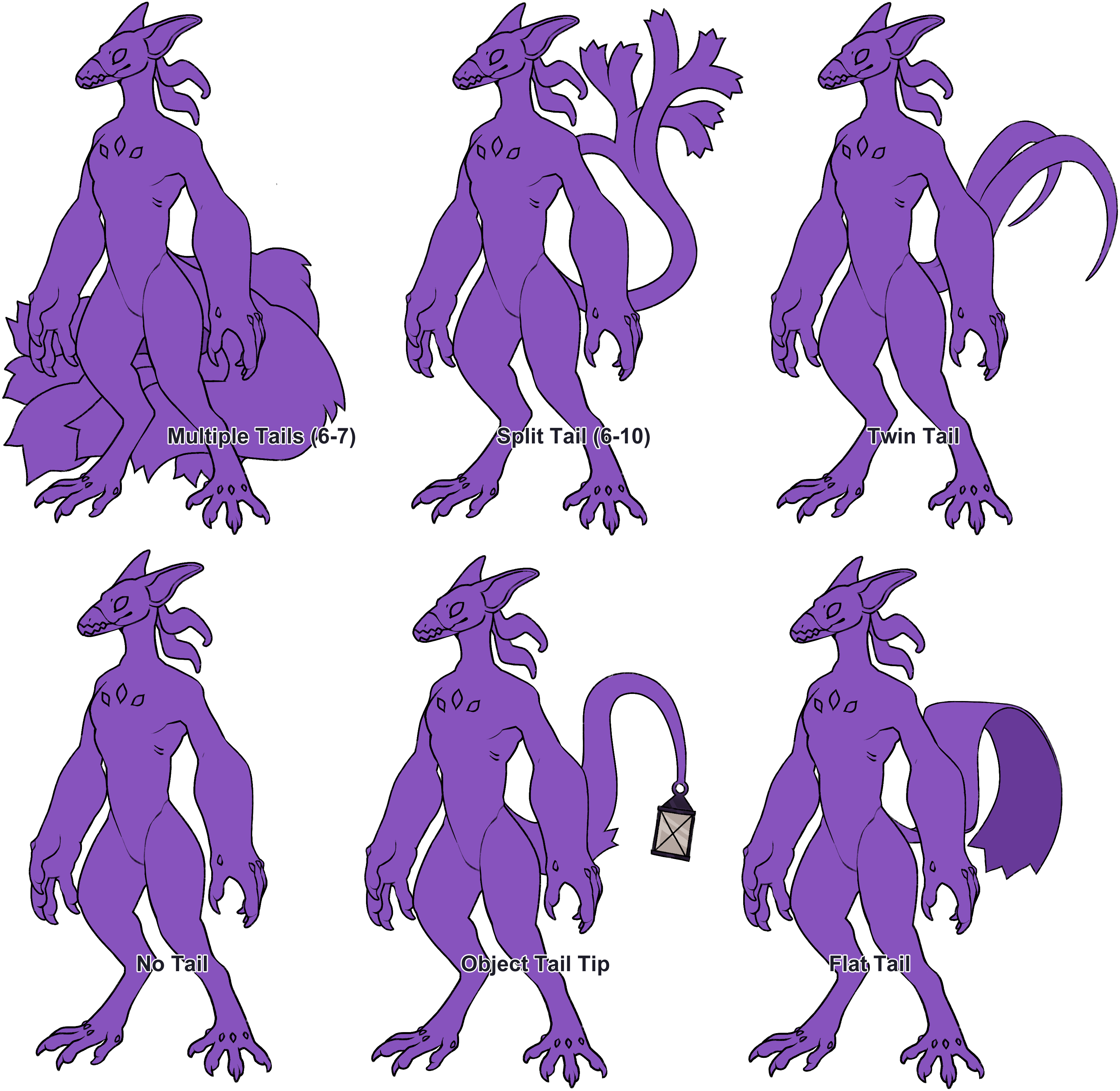
Myth
- Multiple Tails (8-9)
- Split Tail (11-15) - [Tail splits to no more than half its length. This can be used to create a branching effect up to 15 times (this number is counted by the number of times the tail splits, not the number of tail tips), but these must not be longer than half the tail length. Branches account for the total number of branches across all tails]
- Hand Tail - [Tail ends in a hand. Hand must be similar in size to standard body hands]
- Overgrown (Tail) - [Tail that is very clearly larger than is proportional to the character]
- Aquatic Host (Tail) - [Tail that has aquatic features usually noted by a caudal fin. The trait naturally allows webbing and gills as a default option without additional usage.]
- Arthropod Host (Tail) - [Tail that has arthropod features usually noted by a chitin plating, antennae, etc. The trait naturally allows chitinous plating and small mouth/face mandibles without additional usage.]
Myth Tail Visual Examples
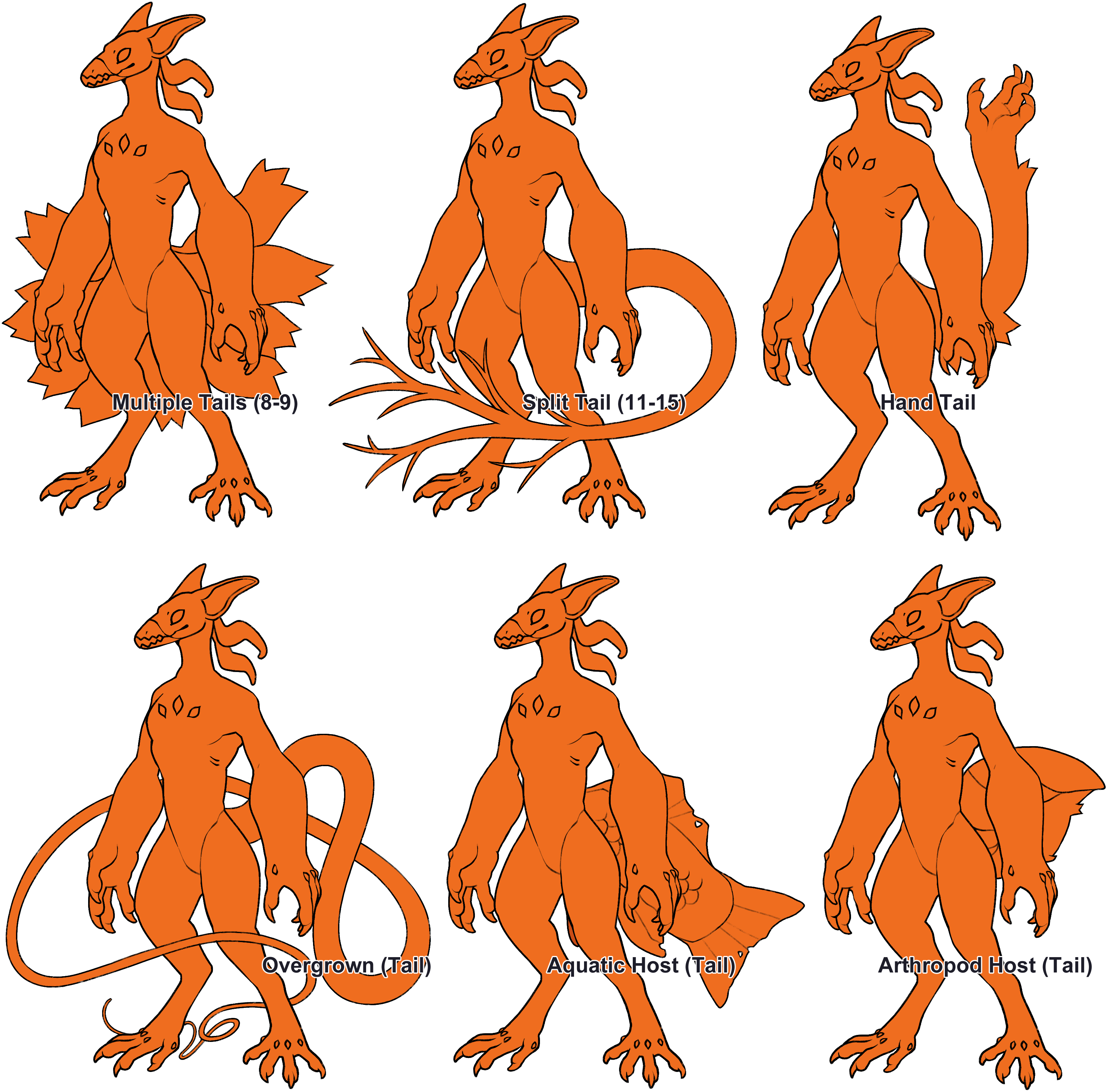
Oddity
Oddity Tail Visual Examples
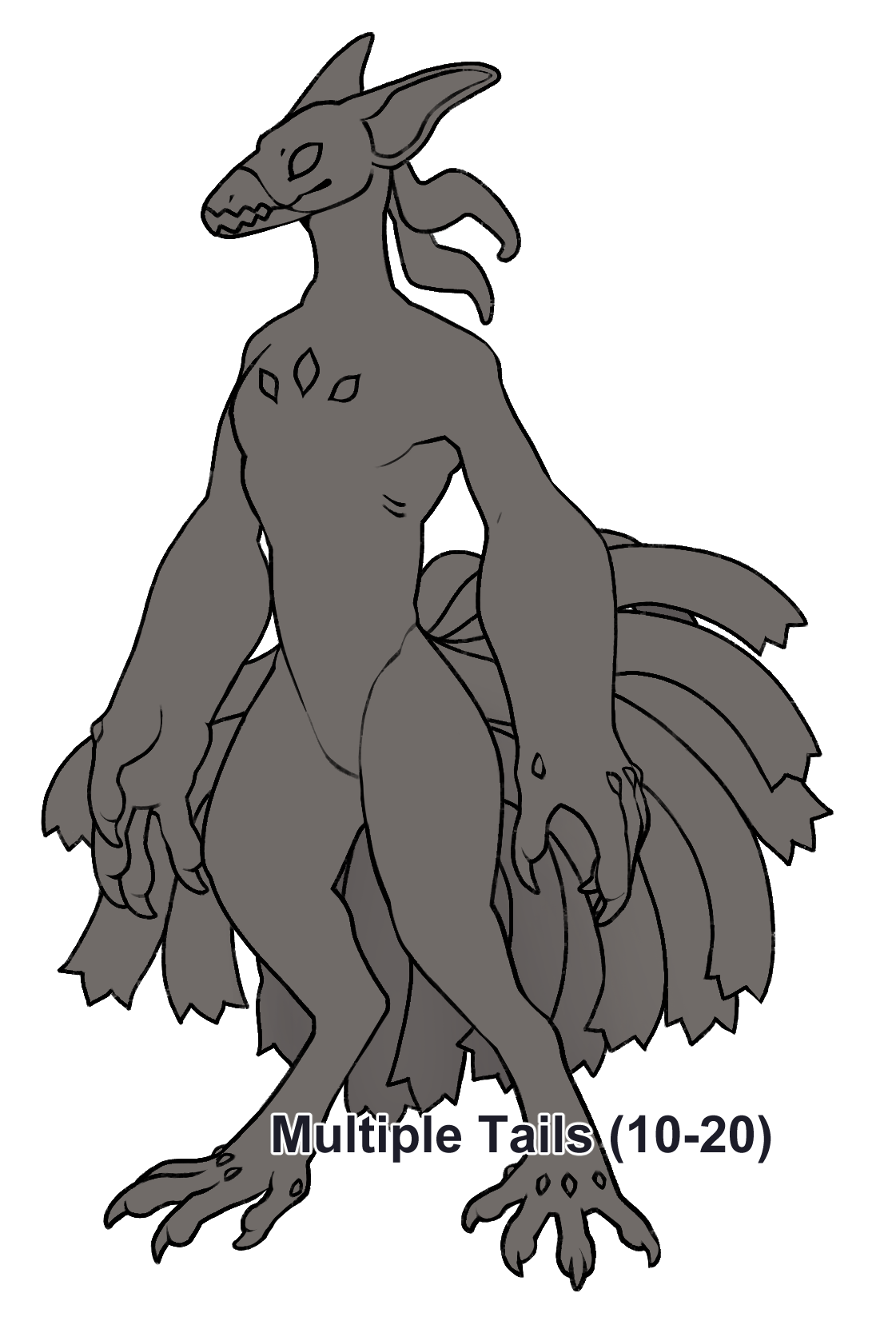
Unseen Affliction
- -
Lore-breaking
- -
Required
- 4 Limbs - [Any lost due to injury are not traited]
- 1 Head Minimum
- 3 Fingers and 1 Thumb - [Counts for front and back feet, though feet have slightly different anatomy than CCCat hands]
- Knuckle Bones - [Small, bone like protrusions that serve as weapon pieces on the hands and feet]
- Nostril
- Enlarged Forearms - [Crooks gain large forearms as part of their defensive capabilities]
Common
- Body Type - [Bony, Thin, Athletic, Chubby, Fat, etc are all possible]
- Alternate Forms - [Crooks can canonically shift between a humanoid form, anthro form, sphinx form, centaur form, faun form, etc. These must resemble the official base form of the design, and should not have trait or design changes]
- Human Form - [Crooks can shift into a near-human form. They retain their face patch and eye clusters even in a human form. They must also keep their pointy teeth]
- Horns/Spikes - [Anywhere on body, any amount that does not obscure the Crook. Includes antlers]
- Varying Head Shapes - [Any head shape, however it cannot be humanoid]
Common Body Visual Examples

Uncommon
- Floating Body Piece (1-5) - [Small, shaped object floating separately from the body. Must be extension from an existing part, that can include horns, tail tips, and more]
- Raptor Claw - [One very large hooked claw on both hands, both feet, or both hands and both feet]
- Spade Claws - [The claws have an extra spike facing backwards, appearing double ended]
- Pad Claws - [The claws extend further down to create hard finger pads]
- Snail Nails - [The claws have an internal curl present]
- Lip Tags - [The lip has protruding shapes. These can be pointed, zipper shaped, or akin to eyelashes. For Crooks, this comes from the edge of the face patch]
- Pacifist Paws - [Feet, Hands, or both are paws. Claws are retractable but must still exist]
- Connected Knuckles - [Knuckles connect from one to another on the same hand or foot]
- Multi-Colored Knuckles - [Implies multicolored bones]
- Quills/Whiskers - [Thin long strands that grow on the body. Not a fur type, and cannot have complex shapes]
Uncommon Body Visual Examples

Rare
- Floating Body Piece (6-10) - [Small, shaped object floating separately from the body. Must be extension from an existing part, that can include horns, tail tips, and more]
- Feather Growth - [Feathers growing anywhere on the body. Can cover the entire body]
- Scale Growth - [Scales growing anywhere on the body. Can cover the entire body
- Split Hands/Feet - [Hands and/or feet are divided down the center, allowing hands to function more chameleon-like]
Rare Body Visual Examples

Myth
- Floating Body Piece (11-15) - [Small, shaped object floating separately from the body. Must be extension from an existing part, that can include horns, tail tips, and more]
- Aquatic Host - [Any part of the design resembling an aquatic creature counts as 1 myth trait, however the trait naturally allows webbing and gills as a default option without additional usage. Examples are fins, anglers, octopus tentacles, etc.]
- Arthropod Host - [Any part of the design resembling an insect, arthropod, or arachnid counts as 1 myth trait, however the trait naturally allows allows chitinous plating and small mouth/face mandibles without additional usage. Examples are segmented limbs, antennae, etc.]
- Hooves - [Feet, Hands, or both are hooves]
- Fused Mouth - [The mouth is connected by strips of skin]
- Vocal Sac - [The neck contains an inflatable sac that allows a croaking noise]
- Cobra Hood - [The neck can flare out like a cobra hood]
- Funky Feet - [Any difference in hand or feet shape, such as a dew claw or naturally missing fingers]
- Overgrown (Body) - [Body parts that are very clearly larger than are proportional to the character. This trait can work on a single group of body parts, such as arms, legs, hands, body, or neck. Specific aspects will be listed in the trait's notes on each individual design]
- Unusable Limbs - [Small additional limbs that have digits/joints that are unable to grab or grip objects. These can appear on their own anywhere on the body or attached to other limbs, with the hand/arm's anatomy noticeably changed]
- Object Growth - [The design grows some form of object across its body. This covers one type of item, even if that specific item (ie: wires) has more than one material. This can affect or replace the crown with the same object type]
Myth Body Visual Examples
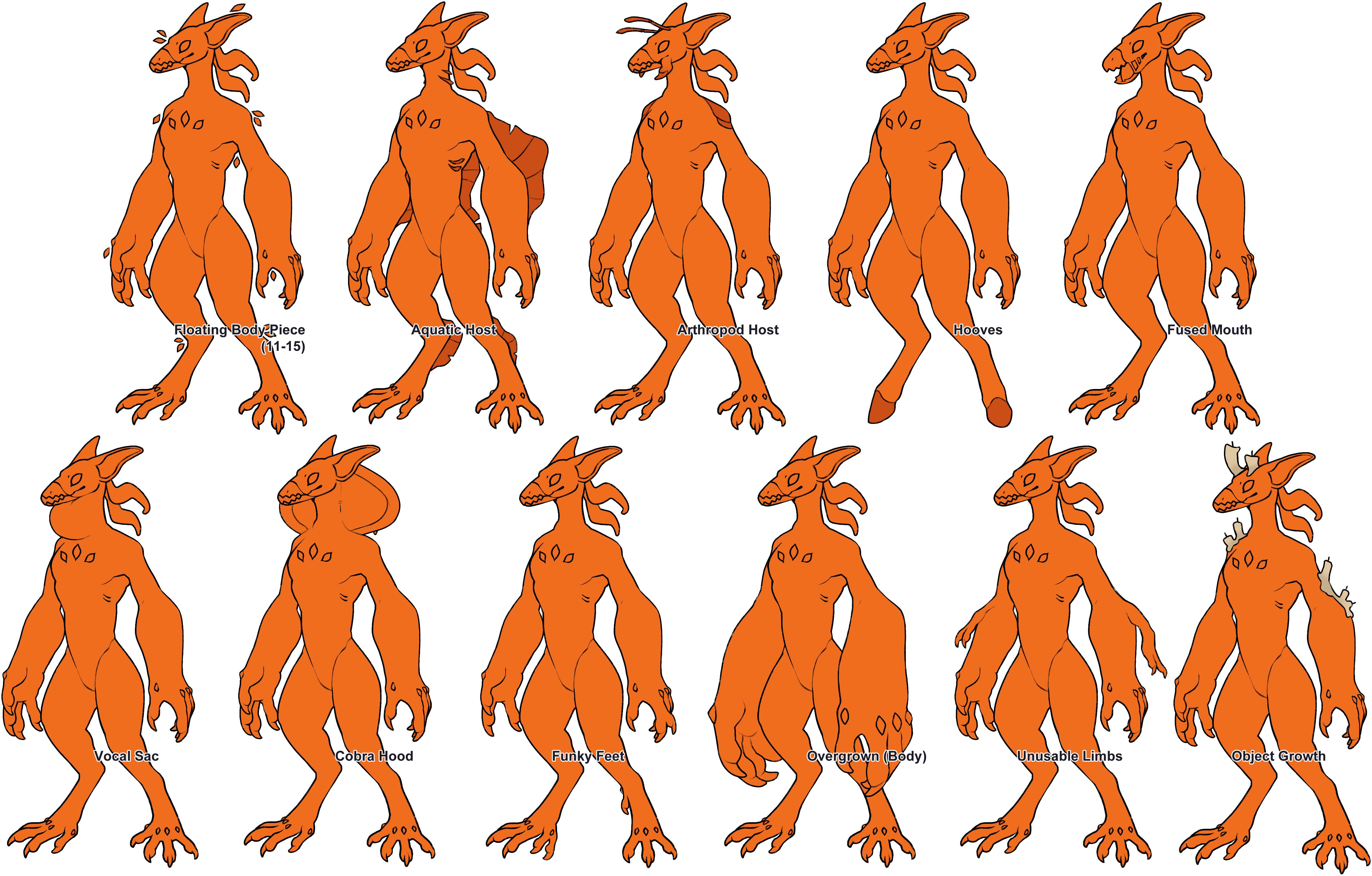
oddity
- Multiple Forms - [The design has more than one form. Forms must be of the same base species as the rest of the forms. Each new form requires x1 extra of this trait]
- Floating Body Piece (16-20) - [Small, shaped object floating separately from the body. Must be extension from an existing part, that can include horns, tail tips, and more]
- Extra Mouths - [Any extra mouth above 3 total mouths (this includes the mouth on the face, meaning the body can have up to two more mouths) counts as an extra touched trait. The extra mouths can be anywhere else on the body as long as one remains on the face. Each mouth can have a tongue, but once the tongues differ from one another it is considered multiple tongues]
- Extra Head - [An extra head in a normal position or elsewhere such as the tail]
- Extra Limbs - [Any extra set of limbs above 3 sets total counts as an extra touched trait]
- Mouth Elsewhere On Body - [A mouth that is elsewhere from its proper place on the face]
- Repositioned Mouth - [The mouth is positioned non-standardly on the face, such as horizontal or diagonal]
- Separated Wormling - [The wormling exists outside of the host body]
- Altered Anatomy - [Anatomy is altered, such as adding an extra joint to a limb, or a wyvern like set of arms]
- Transparent Appendages - [Affects up to two appendages, i.e., head and tail per trait instance]
- Peg Legs - [Limbs do not end in a hand or foot, rather a peg]
- Wings - [Any Extra set above 2 total sets of wings counts as an extra Oddity trait]
- Exposed Bone - [Due to injury, bone remains exposed]
- Inanimate Host - [Crook takes a host that is inanimate or an object, and the body is influenced by this. This trait is displayed as part or all of the host being replaced with the specific object as part of its body]
- Split Jaw - [The jaw is split down the middle]
- Second Jaw - [An inner jaw matching the external jaw is present inside the mouth]
- CCCat Mutation - [The Crook loses both true eyes and cluster eyes, gaining instead an external eye and crowns akin to a CCCat. Their wormling becomes the tongue, becoming long. These follow the eye and tongue traits of CCCats.]
Crooks may also:- Have a neck with an eye pouch.
- Have crowns dispersed across the body, following the behavior of clusters. Crowns can be clustered anywhere on the body, and can cluster symmetrically. Crowns follow crown traits in the CCCat Traits category.
- Keep their tendrils alongside body crowns.
- Lose their knuckle bones
Oddity Body Visual Examples

Unseen Affliction
- Overgrown Mouth - [The mouth is overgrown on the face or elsewhere, if paired with the Mouth Elsewhere on Body Trait. Often depicted as the mouth continuing off of the skull and down the neck, or overall larger than average]
- Limbless - [The design is naturally missing a set of limbs, such as arms or legs]
- Hallowed - [The body has grooves or holes naturally present]
- Lamprey Mouth - [Teeth are situated in a circle around the mouth. This includes multiple layers]
- Gulper Mouth - [The mouth extends beyond the bounds of the skull and can open very wide, akin to a gulper eel]
- Headless - [No head is present. CCCATS - A mouth must be present elsewhere on the body (it will naturally form on the neck if the head is missing), and crowns will form naturally on the neck]
- Wormling Body - [Part of the body is replaced by the wormling, such as the tail]
- Fullbody Transparency - [The whole body is able to be affected by transparency]
Unseen Body Visual Examples

Lore-breaking
- -
Misc
Required
- -
Common
- -
Uncommon
- -
Rare
- -
Myth
- Chibi Size - [Available to Crooks that possess a myth trait or higher. Does not count as an extra trait. Min 5'0"]
- Monster Size - [Available to Crooks that possess a myth trait or higher. Does not count as an extra trait. 10'0"]
oddity
- Extra Tiny - [The Crook is smaller than is standard. It cannot be so miniscule that it is invisible. This does not count as an extra trait, and is available to Crooks that possess an Oddity trait. Min 4'0"]
- Extremely Large - [The Crook is larger than is standard. It cannot be impossibly large. This does not count as an extra trait, and is available to Crooks that possess an Oddity trait. Max 12'0"]
Unseen Affliction
- -
Splice
- Splice - [A fusion of a Crook and another Skire species, resulting in the Crook displaying traits of this species. CCCat Mutation is the splice equivalent for the two species]